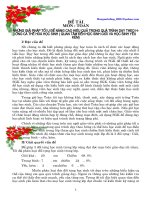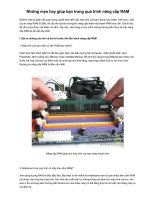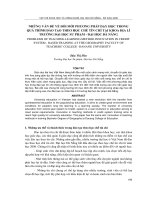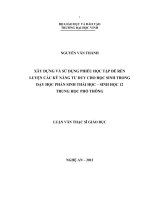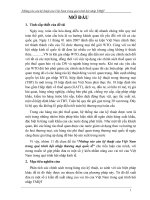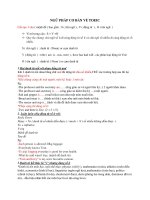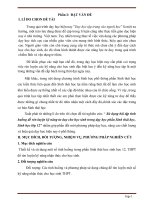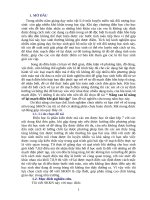Examinee handbook TOEIC
Bạn đang xem bản rút gọn của tài liệu. Xem và tải ngay bản đầy đủ của tài liệu tại đây (2.22 MB, 24 trang )
Listening.
Learning.
Leading.
Examinee Handbook
About the TOEIC test . . . . . . . . . . . . . . . . . . . . . . . . 2
TOEIC Test Format . . . . . . . . . . . . . . . . . . . . . . . . . . . . . . . . 2
Who takes the TOEIC test . . . . . . . . . . . . . . . . . . . . . . . . . . . 2
Frequently asked questions . . . . . . . . . . . . . . . . . . 2
Why take the TOEIC test? . . . . . . . . . . . . . . . . . . . . . . . . . . . 2
When and where can I take the TOEIC test? . . . . . . . . . . . . . 2
How much does the TOEIC test cost? . . . . . . . . . . . . . . . . . . 2
What score do I need to “pass” the TOEIC test?. . . . . . . . . . . 2
From what kind of contexts are the TOEIC test
questions drawn? . . . . . . . . . . . . . . . . . . . . . . . . . . . . . . . . 3
If I have a disability, can I still take the TOEIC test? . . . . . . . 3
Certificate of Achievement . . . . . . . . . . . . . . . . . . 3
Preparing to take the TOEIC test . . . . . . . . . . . . . . 4
How to get ready to take the TOEIC test . . . . . . . . . . . . . . . . 4
During the test . . . . . . . . . . . . . . . . . . . . . . . . . . . . . . . . . . . . 4
Identification Requirements . . . . . . . . . . . . . . . . . . . . . . . . . . 4
Test Center Procedures and Regulations . . . . . . . . . . . . . . . . . 6
Dismissal from Test Session. . . . . . . . . . . . . . . . . . . . . . . . . . . 6
Sample Questions . . . . . . . . . . . . . . . . . . . . . . . . . . 7
General Directions . . . . . . . . . . . . . . . . . . . . . . . . . . . . . . . . . 7
Section 1: Listening . . . . . . . . . . . . . . . . . . . . . . . . . . . . . . . . 7
Section 2: Reading . . . . . . . . . . . . . . . . . . . . . . . . . . . . . . . . 10
TOEIC Background Questionnaire
and Answer Sheet . . . . . . . . . . . . . . . . . . . . . . . . 13
Background Questionnaire . . . . . . . . . . . . . . . . . . . . . . . . . . 13
Answer Sheet. . . . . . . . . . . . . . . . . . . . . . . . . . . . . . . . . . . . . 13
Accent Marks . . . . . . . . . . . . . . . . . . . . . . . . . . . . . . . . . . . . 13
Group Code . . . . . . . . . . . . . . . . . . . . . . . . . . . . . . . . . . . . . 13
Custom Codes . . . . . . . . . . . . . . . . . . . . . . . . . . . . . . . . . . . 13
Sample Background Questionnaire . . . . . . . . . . . . . . . . . . . . 14
Sample Answer Sheet . . . . . . . . . . . . . . . . . . . . . . . . . . . . . . 16
TOEIC Test Scores . . . . . . . . . . . . . . . . . . . . . . . . . 18
Score Reports . . . . . . . . . . . . . . . . . . . . . . . . . . . . . . . . . . . . 18
Interpreting Scores . . . . . . . . . . . . . . . . . . . . . . . . . . . . . . . . 18
Repeat Test Takers. . . . . . . . . . . . . . . . . . . . . . . . . . . . . . . . . 20
Score Validity . . . . . . . . . . . . . . . . . . . . . . . . . . . . . . . . . . . . 20
Test Score Data Retention. . . . . . . . . . . . . . . . . . . . . . . . . . . 20
Confidentiality of TOEIC Scores . . . . . . . . . . . . . . . . . . . . . 20
Rescore Requests . . . . . . . . . . . . . . . . . . . . . . . . . . . . . . . . . . 20
Comments . . . . . . . . . . . . . . . . . . . . . . . . . . . . . . . . . . . . . . 20
For more information, visit us on the Web at
www.ets.org/toeic
or contact your local ETS representative. If there is no ETS representative
in your country, please contact us at:
TOEIC Program
Educational Testing Service
Rosedale Road
Princeton, NJ 08541
Phone: 1-609-771-7170
Fax: 1-609-771-7111
E-mail:
The TOEIC Program International does not operate, license, endorse, or recommend any schools or study materials that claim to prepare people for the TOEIC test
or that promise to improve a person’s test score.
Copyright © 2006 by Educational Testing Service. All rights reserved.
EDUCATIONAL TESTING SERVICE, ETS, the ETS logo, TEST OF ENGLISH FOR INTERNATIONAL COMMUNICATION, TOEIC, and the TOEIC logo
are registered trademarks of Educational Testing Service.
Table of Contents
TOEIC Examinee Handbook Contents
1
About the TOEIC Test
The TOEIC® (Test of English for International Communication)
test is an English language proficiency test for people whose native
language is not English. It measures the everyday English skills of
people working in an international environment. The scores indi-
cate how well people can communicate in English with others in
business, commerce, and industry. The test does not require spe-
cialized knowledge or vocabulary beyond that of a person who
uses English in everyday work activities.
TOEIC Test Format
The TOEIC test is a two-hour multiple-choice test that consists of
200 questions divided into two sections:
Ⅲ
Listening Section: The Listening section tests how well you
understand spoken English. It consists of four parts and con-
tains 100 questions administered by audiocassette or CD. You
will be asked to answer questions based on a variety of state-
ments, questions, short conversations, and short talks recorded
in English. Total time: approximately 45 minutes.
Ⅲ
Reading Section: The Reading section includes three parts test-
ing how well you understand written English. You will read a
variety of materials and respond at your own pace to 100 ques-
tions based on the content of the materials provided to you.
Total time: 75 minutes.
You will respond to test questions by marking one of the letters
(A), (B), (C), or (D) with a pencil on a separate answer sheet.
Although the actual testing time is approximately two hours, addi-
tional time is needed to allow you to complete the TOEIC
background questionnaire on the answer sheet. Therefore, you
should allow approximately 2.5 hours to take the test.
Who takes the TOEIC test
Ⅲ
personnel who use English in real-life work settings, such as
businesses, hotels, hospitals, restaurants, international meetings,
conventions, and sports events
Ⅲ
managerial, sales, and technical employees in international
business, commerce, and industry who require English for
their work
Ⅲ
candidates for training to be conducted in English
Ⅲ
individuals in English-language training programs
Frequently Asked Questions
Why take the TOEIC test?
The TOEIC test is the choice of more than 4 million examinees a
year and is recognized by thousands of corporations. As a fair and
objective measure of English proficiency, the TOEIC test will
enable you to:
Ⅲ
verify your current level of English proficiency
Ⅲ
qualify for a new position and/or promotion in a company
Ⅲ
enhance your professional credentials
Ⅲ
monitor your progress in English
Ⅲ
set your own learning goals
Ⅲ
involve your employer in advancing your English ability
When and where can I take the TOEIC test?
The TOEIC test is available throughout the world. Testing can be
arranged through corporations or other organizations that ask
employees or job applicants to take the TOEIC test. In addition,
many language-training programs and schools offer TOEIC test-
ing. If testing has not been arranged through your organization,
you can contact your local ETS TOEIC representative to find out
when and where you can take the test.
How much does the TOEIC test cost?
TOEIC prices vary worldwide. To inquire about pricing in your
area, contact your local ETS TOEIC representative.
What score do I need to “pass” the TOEIC test?
The TOEIC test is not the kind of test that one “passes” or “fails.”
Not every job or task requires the same level of English profi-
ciency. Because it was developed specifically to meet the needs of
the workplace, the TOEIC test measures many levels of ability. It
enables people to demonstrate what they currently can accomplish
in English. The single, continuous scale also makes it possible for
learners to set attainable goals and to measure their progress as
their English improves.
Many companies use the TOEIC test to set their own score
standards based on the levels of English necessary to carry out par-
ticular responsibilities. Your company may require employees to
have a minimum TOEIC score due to the corresponding level of
English that is needed on the job. Many companies offer English
training to help their employees reach target TOEIC scores which
reflect specific levels of proficiency based on professional need.
2 About the TOEIC Test www.ets.org/toeic
Frequently Asked Questions
(continued)
TOEIC Examinee Handbook Frequently Asked Questions
3
Ⅲ
Offices: board meetings, committees, letters, memoranda,
telephone, fax and e-mail messages, office equipment and
furniture, office procedures
Ⅲ
Personnel: recruiting, hiring, retiring, salaries, promotions,
job applications, job advertisements, pensions, awards
Ⅲ
Purchasing: shopping, ordering supplies, shipping, invoices
Ⅲ
Technical Areas: electronics, technology, computers, laborato-
ries and related equipment, technical specifications
Ⅲ
Travel: trains, airplanes, taxis, buses, ships, ferries, tickets,
schedules, station and airport announcements, car rentals,
hotels, reservations, delays and cancellations
If I have a disability, can I still take the
TOEIC test?
If you require special testing arrangements because of a disability,
please contact your local TOEIC representative office to discuss
your needs at least two weeks in advance of the test date. Your
representative will make every effort to accommodate you. There
is no additional cost for special accommodations.
From what kind of contexts are the TOEIC test
questions drawn?
These are some examples of the settings and situations you may
find in TOEIC test questions:
Ⅲ
Corporate Development: research, product development
Ⅲ
Dining Out: business and informal lunches, banquets, recep-
tions, restaurant reservations
Ⅲ
Entertainment: cinema, theater, music, art, exhibitions,
museums, media
Ⅲ
Finance and Budgeting: banking, investments, taxes,
accounting, billing
Ⅲ
General Business: contracts, negotiations, mergers, marketing,
sales, warranties, business planning, conferences, labor relations
Ⅲ
Health: medical insurance, visiting doctors, dentists, clinics,
hospitals
Ⅲ
Housing/Corporate Property: construction, specifications,
buying and renting, electric and gas services
Ⅲ
Manufacturing: assembly lines, plant management, quality
control
Certificate of Achievement
The TOEIC Certificate of Achievement is an acknowledgement of
your English proficiency. The TOEIC Certificate of Achievement
is not available through some services. Contact your local represen-
tative for availability.
The Certificate of Achievement features:
Ⅲ
your name
Ⅲ
your scores
Ⅲ
test date and location
Ⅲ
administering organization
Ⅲ
watermark on back
Ⅲ
a format that is suitable for framing
E
DIS E
S
REV
E
R
N
O
KRAMRETAW
SA
H
TNEM
U
CO
D
L
AN
IG
IR
O
10
25
27
85
2
4
1
1
C
FOET
A
CI
F
I
T
RE
A
TNEMEVEI
H
C
t
a
h
t yf
i
tre
c
o
t si s
i
hT
e
ma
N
r
u
o
Y
e
h
t
n
o
s
er
o
c
s
g
n
iwo
ll
of
eh
t
d
ev
e
i
hc
a
n
o
i
t
a
cin
u
mm
o
C lanoitanretnI rof hsilgnE fo tseT
g
n
inets
i
L 5
gnid
a
eR
5
l
a
to
T 01
:f
o
sec
ip
su
a
eht
red
nu
der
e
tsi
n
i
m
da sa
r
e
t
n
eC
ts
eT
r
u
o
Y
:t
a
:
e
ta
d
5
0
02-yrauna
J-10
EL
A
CS C
I
EO
T
594-5 :gninetsiL
59
4
-5 :gn
i
dae
R
09
9-01
:la
t
oT
4 Preparing to take the TOEIC test www.ets.org/toeic
Identification Requirements
All test takers must read Part 1. Depending on whether you will
be testing within or outside your country of citizenship, you must
also read either Part 2 or Part 3, as appropriate.
Part 1: Information for all Test Takers
Ⅲ
You must have acceptable and valid ID with a signature and
photograph to be admitted to a test center. Identification
requirements are strictly enforced. It is your responsibility
to read and understand the instructions and requirements.
Ⅲ
If you arrive at the test center without the required identifica-
tion, the test administrator will not admit you, you cannot test,
and you forfeit your test fee.
When registering for the test, you must use exactly the same
name that appears on the primary identification document you
will present at the test center. Make sure to provide your entire
first (given name) and entire surname (family name). DO NOT
register under a nickname. If the name shown on your primary
identification does not match the name on the registration, you
will not be permitted to test.
Ⅲ
Only misspellings of your name can be corrected at check-in—
NAME CHANGES WILL NOT BE MADE. If your name
has changed for any reason, including marriage, you must still
present primary identification under the name you registered,
or you will not be permitted to test.
Ⅲ
If the test center administrator questions the ID you present,
you will be required to present additional proof of identity.
If positive confirmation cannot be made, you may be refused
admission to the test center and forfeit your test fee.
Ⅲ
Admittance to the test center does not imply that your form
of identification is valid or that your scores will be reported.
Test center personnel will check your identification before
assigning you a seat at the test center. The administrator will
check your signature to verify that you are the person in your
photo identification.
How to get ready to take the TOEIC test
The TOEIC test is not based on the content of any particular
English course, but rather on your proficiency—your overall
ability to use English. Improvement in proficiency may take
some time and is generally achieved through a combination of
practice and study. The TOEIC test does not test “business
English,” and you are not required to know specialized business
and technical vocabulary beyond that of a person who uses
English in everyday work activities.
Before taking the TOEIC test, there are several things you can
do to prepare for the test and improve your English proficiency.
Ⅲ
Become familiar with the test format and how to mark your
answers on the answer sheet. You can then focus your attention
on the questions themselves, rather than on the format. Review
carefully the test directions and the sample questions on pages
7–12 and the sample answer sheet and sample Background
Questionnaire on pages 14–17.
Ⅲ
Immerse yourself in the language as frequently as possible and
in as many ways as possible if it has been some time since you
have had contact with English. Reading, watching TV and
videos, listening to tapes, taking an English course, and speak-
ing with friends and colleagues are some of the ways to practice
English.
During the test
Ⅲ
Work quickly and carefully.
Ⅲ
Do not spend too much time on any one question.
Ⅲ
Mark your answers on your answer sheet and not in the test
book.
Ⅲ
Mark only one answer for each question.
Ⅲ
Try to answer every question to the best of your ability.
Ⅲ
Pay close attention to the time during the Reading section of
the test. In the Reading section (75 minutes) you have to pace
yourself—so work quickly and if you do not know the answer
to a question, come back to it later.
Ⅲ
You may not use note paper. You will receive credit only for
answers marked in the circles on the answer sheet. Your score
will be based on the number of questions you answer correctly.
If you mark more than one answer, that question will be
counted wrong—even if one of the answers you marked
is correct.
Preparing to take the TOEIC test
TOEIC Examinee Handbook Preparing to take the TOEIC test
5
Part 2: If Testing WITHIN Your Country of Citizenship
Only one form of primary ID is needed if your primary ID docu-
ment contains a photograph and signature. Please see the list of
acceptable primary ID documents on this page. However, if the
test administrator has any concerns about the primary ID docu-
ment, you will be required to present a secondary ID from the list
on this page.
If your primary ID does not contain your signature, you must
either sign the document or present an additional ID from the list
of secondary identification documents. The secondary ID cannot
be expired and must contain a recent, recognizable photograph
and your signature.
Part 3: If Testing OUTSIDE Your Country of Citizenship
You MUST PRESENT YOUR PASSPORT as your primary iden-
tification document (citizens of European and Schengen Zone
countries, see special requirements below). If you do not meet this
requirement, your test scores may not be reported.
If your passport is not written in English Language Letters,
you must also present an additional ID from the list of secondary
identification documents (see Part 1) that contains a recent, recog-
nizable photo and is in English.
If your passport does not contain your signature, you must
either sign your passport or present an additional ID from the list
of secondary identification documents (see Part 1).
European Union/Schengen Zone Countries
If you are taking the test within a European Union or Schengen
Zone country outside your own, you may use your valid national
or European identity card if you have one. The card you present
must contain a recent, recognizable photograph, your date of
birth, and your signature. If your form of identification is not in
English language letters and the test administrator cannot read
the language in which it is written, you may not be allowed to
test. If your official ID does not contain your signature, you must
present an additional document from the list of secondary identi-
fication documents (see Part 1) that does contain your signature.
Acceptable Primary Identification Documents
Ⅲ
passport with photograph and signature
Ⅲ
driver’s license with photograph and signature
Ⅲ
state identification with photograph and signature
Ⅲ
national identification with photograph and signature
Ⅲ
military identification with photograph and signature
Acceptable Secondary Identification Documents
If your primary identification is missing either a photograph or
signature, you must present one of the following secondary IDs
that can be used to meet the photograph or signature require-
ment; you must present one of the following secondary IDs in
addition to your primary ID. Secondary IDs that can be used to
meet the photograph or signature requirements are:
Ⅲ
a government-issued identification document that has not
expired including but not limited to passport, driver’s license,
state identification, national identification, or military iden-
tification. (There are some exceptions: see “Unacceptable
Identification Documents” below.)
Ⅲ
student ID
Unacceptable identification Documents
Ⅲ
any expired ID
Ⅲ
draft classification card
Ⅲ
credit card of any kind
Ⅲ
Social Security card
Ⅲ
learner’s permit or any temporary identification document
Ⅲ
international driver’s license
Ⅲ
international student ID
Ⅲ
notary-prepared letter or document
Ⅲ
employee identification card
If you cannot meet the specified ID requirements or if you
have questions about ID, please contact your local ETS TOEIC
representative before registering for the test.
Preparing to take the TOEIC test
(continued)
6 Preparing to take the TOEIC test www.ets.org/toeic
dictionaries, translators, and any handheld electronic or photo-
graphic devices
Ⅲ
creating a disturbance (disruptive behavior in any form will not
be tolerated; the test administrator/supervisor has sole discre-
tion in determining what constitutes disruptive behavior)
Ⅲ
attempting to give or receive assistance, or otherwise commu-
nicate in any manner with another person about the content of
the test during the administration, during breaks, or after the
test
Ⅲ
removing or attempting to remove test content, scratch paper,
or notes relating to the test content from the test center. Under
no circumstances may test content or any part of the test con-
tent be removed, reproduced, and/or disclosed by any means
(e.g., hard copy, verbally, electronically) to any person or entity.
Ⅲ
using scratch paper during untimed sections of the test or
during breaks
Ⅲ
tampering with a computer
Ⅲ
taking a weapon or firearm into the test center
Ⅲ
taking food, drink, or tobacco into the testing room
Ⅲ
leaving the test center vicinity during the test session or
during breaks
Ⅲ
leaving the testing room without permission
Ⅲ
taking excessive or extended unscheduled breaks during the
test session. Test center administrators are required to strictly
monitor unscheduled breaks and report test takers who take
excessive or extended breaks.
Ⅲ
referring to, looking through, or working on any test, or test
section, when not authorized to do so, or working after time
has been called
Ⅲ
failing to follow any of the test administration regulations in
this examinee handbook, given by the test administrator/super-
visor, or specified in any test materials
Ⅲ
The local ETS TOEIC representative reserves the right to take
all action—including, but not limited to, barring you from
future testing and/or canceling your scores—for failure to
comply with test administration regulations or the test admin-
istrator/supervisor’s directions. If your scores are canceled, they
will not be reported, and your fees will not be refunded.
Test Center Procedures and Regulations
The following procedures and regulations apply during the entire
test session, which begins when you are admitted to the test center
and ends when you leave the test center.
Ⅲ
No test taker will be admitted after test materials have been
distributed.
Ⅲ
Books, dictionaries, papers, notes, rulers, calculators, watch
alarms, mobile phones, listening devices, recording or
photographic equipment, highlighters, or aids of any kind
are not allowed in the testing room.
Ⅲ
Paper of any kind is not permitted in the testing room.
Ⅲ
You may not mark or underline words in the test book or make
notes in the test book or on the answer sheet.
Ⅲ
You must have the supervisor’s permission to leave the testing
room. Any lost time cannot be made up.
Ⅲ
There is no scheduled break during the TOEIC test. If you
must leave the testing room, you are required to give the
supervisor your identification document(s) before you leave the
room. You will not be permitted to make up the time you lose.
Ⅲ
At the conclusion of the test you will be required to return
your test book and answer sheet to the test supervisor.
Dismissal from Test Session
A test administrator/supervisor is authorized to dismiss you from a
test session/or your scores may be canceled, due to violations such
as but not limited to the following:
Ⅲ
attempting to take the test for someone else or having someone
else take the test for you
Ⅲ
failing to provide acceptable identification
Ⅲ
obtaining improper access to the test, a part of the test, or
information about the test
Ⅲ
using a telephone or cell phone during the test session or
during breaks
Ⅲ
using any aids in connection with the test, such as mechanical
pencils, pens, pagers, beepers, calculators, watch calculators,
books, pamphlets, notes, rulers, highlighter pens, stereos or
radios with headphones, cell phones, watch alarms (includ-
ing those with flashing lights or alarm sounds), stopwatches,
Preparing to take the TOEIC test
(continued)
Sample Questions
TOEIC Examinee Handbook Sample Questions
7
Section I: Listening
In this section of the test, you will have the chance to show
how well you understand spoken English. There are four parts
to this section, with special directions for each part.
Part I: Photographs
Directions: For each question, you will see a picture in your
test book and you will hear four short statements. The state-
ments will be spoken just one time. They will not be printed in
your test book, so you must listen carefully to understand what
the speaker says.
When you hear the four statements, look at the picture in
your test book and choose the statement that best describes
what you see in the picture. Then, on your answer sheet find
the number of the question and mark your answer. Look at the
sample below.
Example
You will hear: Now listen to the four statements.
(A) They’re looking out of the window.
(B) They’re having a meeting.
(C) They’re eating in a restaurant.
(D) They’re moving the furniture.
Statement (B), “They’re having a meeting,” best describes what
you see in the picture. Therefore, you should choose answer (B).
With 200 questions, the TOEIC test measures a wide range of
English proficiency. The following sample questions do not
indicate the full range of difficulties you would find in an
actual TOEIC test.
General Directions
The following general directions are taken directly from the test
book. After the general directions are specific directions for each
part of the test, along with sample questions for each of the parts.
This is a test of your ability to use the English language.
The total time for the test is approximately two hours. It is
divided into seven parts. Each part of the test begins with a set
of specific directions. Be sure you understand what you are to
do before you begin work on a part.
You will find that some of the questions are harder than
others, but you should try to answer each question to the best
of your ability. Your score will be based on the number of ques-
tions you answer correctly.
Do not mark your answers in this test book. You must put
all of your answers on the separate answer sheet that you
have been given. When putting your answer to a question on
your answer sheet, be sure to fill in the answer space corre-
sponding to the letter of your choice. Fill in the space so that
the letter inside the oval cannot be seen, as shown in the exam-
ple below.
Example
Mr. Jones ------- to his accountant yesterday.
(A) talk
(B) talking
(C) talked
(D) to talk
The sentence should read, “Mr. Jones talked to his accountant
yesterday.” Therefore, you should choose answer (C). Notice
how this has been done in the example above.
Mark only one answer for each question. If you change your
mind about an answer after you have marked it on your answer
sheet, completely erase your old answer and then mark your
new answer. You must mark the answer sheet carefully so that
the test-scoring machine can accurately record your test score.
Sample Answer
a b , d
Sample Answer
a , c d
